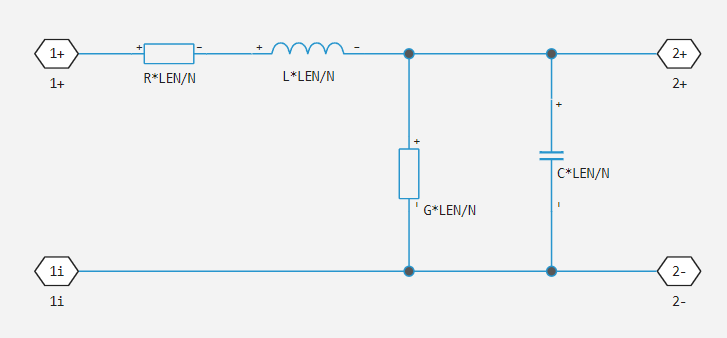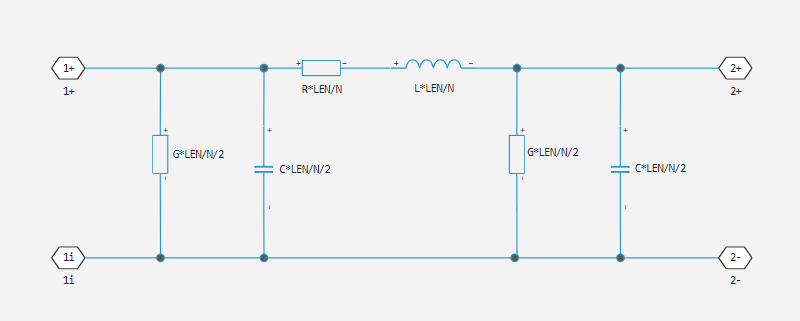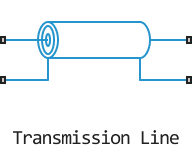Transmission Line
Three-phase power line section with concentrated parameters.
blockType: AcausalElectricPowerSystems.Passive.Lines.Transmission
|
Path in the library: |
Description
The Transmission Line block allows you to simulate one of the following transmission line models:
-
Lumped parameter L-section- a series of series connected L-segments (L-section). -
The
Lumped parameter pi-sectionis a series of series connected P-segments (P-substitution diagram).
L-substitution diagram
The following block diagram shows a model of one L-shaped segment of a transmission line.

The block uses copies of the above segment model connected in series.
The parameters are as follows:
-
- line resistance per unit length.
-
- line inductance per unit length.
-
- line capacitance per unit length.
-
- conductivity of the line per unit length.
-
- line length.
-
- number of consecutive segments.
U-shaped substitution diagram
The following block diagram shows a model of one U-shaped segment of a transmission line.

The block uses copies of such a segment model connected in series. The parameters are defined in the same way as for the L-shaped substitution pattern. In contrast to the L-shaped segment model, the U-shaped segment model is symmetrical.
parameterization of a line with concentrated parameters
Cable manufacturers usually do not specify the inductance per unit length, but instead specify the impedance value. Inductance, capacitance and impedance are related as follows:
The unit allows you to specify or when using a centred parameter model.
Assumptions and constraints
-
It is recommended to use a trapezoidal solver such as `ImplicitEuler'. This is because centred parameter transmission line models have very weakly damped internal dynamics, which is best suited to trapezoidal solvers for numerical accuracy.
-
The `Lumped parameter pi-section' model has a parallel capacitor at both ends. This means that it cannot be connected directly to an ideal voltage source, that is, a source with no internal resistance.
-
The `Lumped parameter L-section' model has a series input resistor, so it can be connected directly to an ideal voltage source.
Ports
The port locations are shown in the figure:

Non-directional
p1 - inner conductor 1
electricity
An electrical port connected to one end of the inner conductor of a transmission line.
n1 is the outer shielding conductor 1
electricity
An electrical port connected to one end of an external shielding conductor of a transmission line.
p2 - inner conductor 2
`electricity'
An electrical port connected to one end of the inner conductor of a transmission line.
n2 is an outer shielding conductor 2
electricity
An electrical port connected to one end of the outer shielding conductor of a transmission line.
Parameters
Model Type - transmission line model type
Lumped parameter L-section | Lumped parameter pi-section
Select one of the following transmission line models:
-
Lumped parameter L-section- modelling the transmission line as a series of series connected L-segments. -
Lumped parameter pi-section- modelling the transmission line as a series of pi-segments connected in series.
parameterization - model parameterization
By characteristic impedance and capacitance (by default) | By inductance and capacitance
Select the method of model parameterization:
-
By characteristic impedance and capacitance- specify the values of the parameters Characteristic impedance and Capacitance per unit length. This is the By default method. -
By inductance and capacitance- specify values for Inductance per unit length and Capacitance per unit length.
Dependencies
This parameter is only used when Lumped parameter L-section or Lumped parameter pi-section is selected for the Model type parameter.
Characteristic impedance - impedance value
50 ohms (by default) | `positive scalar'.
The impedance value of the transmission line. The parameter value must be greater than zero.
Dependencies
This parameter is only used when By characteristic impedance and capacitance is selected for the Parameterization parameter.
Frequency used for rlcg specification - frequency for which RLC parameters are specified
50.0 Hz (By default).
The frequency for which , , , , where:
-
- line resistance per unit length.
-
- line inductance per unit length.
-
- line capacitance per unit length.
-
- conductivity of the line per unit length.
Inductance per unit length - inductance per unit length
220 µGn/m (by default) | positive scalar.
Effective inductance of the transmission line per unit length. The value of the parameter must be greater than zero.
Dependencies
This parameter is only used when Lumped parameter L-section or Lumped parameter pi-section is selected for the Model type parameter and By characteristic impedance and capacitance for the Parameterization parameter.
Capacitance per unit length - capacitance per unit length
90 pF/m (By default).
Transmission line capacitance per unit length.
Dependencies
This parameter is only used when Lumped parameter L-section or Lumped parameter pi-section is selected for the Model type parameter.
Resistance per unit length - resistance per unit length
0.3 ohm/m (by default).
The total resistance of the transmission line (i.e. the sum of the resistances of the two conductive paths) per unit length.
Dependencies
This parameter is only used when Lumped parameter L-section or Lumped parameter pi-section is selected for the Model type parameter.
Insulation conductance per unit length - insulation conductance per unit length
5e-6 cm/m (by default) | non-negative scalar.
The conductance between two conductors of a transmission line per unit length. The value of the parameter must be greater than or equal to zero.
Dependencies
This parameter is only used when Lumped parameter L-section or Lumped parameter pi-section is selected for the Model type parameter.
Line length, km - length of the transmission line
1.0 km (by default).
Transmission line length. The parameter value must be greater than zero.
Number of segments - number of segments of the model
1 (By default)
Number of model segments used to represent the transmission line. The parameter value must be an integer greater than or equal to 1.
